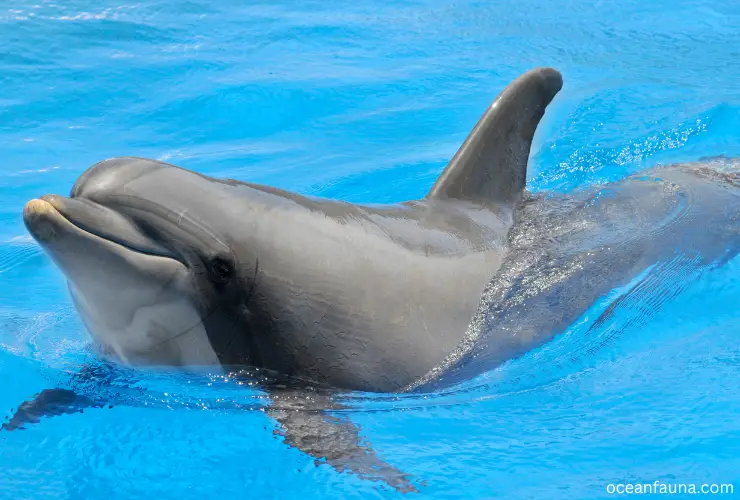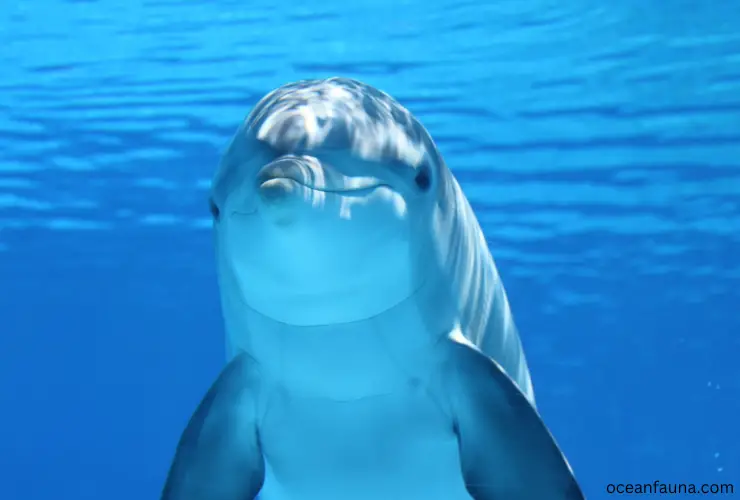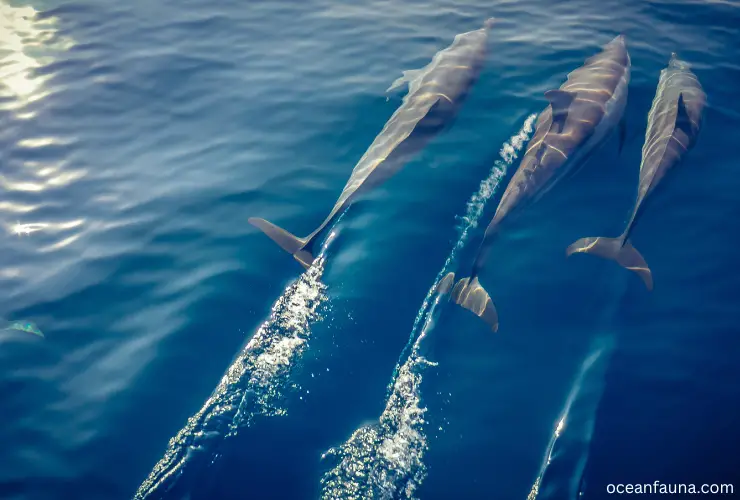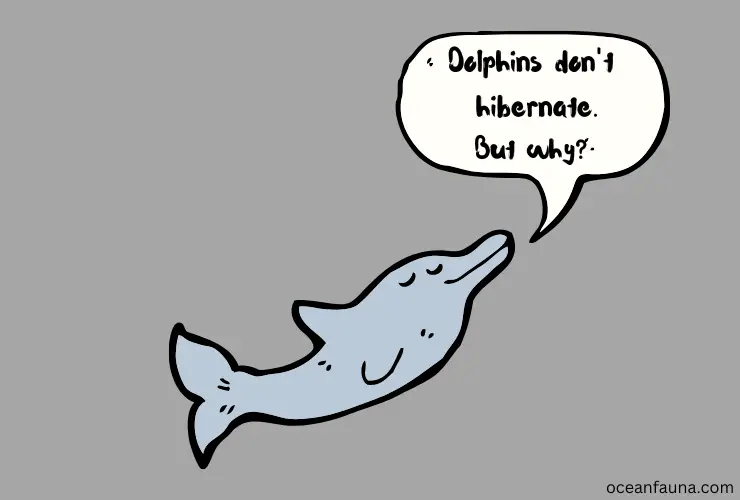No, dolphins do not hibernate since they have to come to the water’s surface to breathe every 10-15 minutes. Also, there are some other reasons as well. However, few of the species do migrate, like a bottlenose dolphin.
In this article, I will explore the reasons why dolphins do not hibernate, their behavior during the winter months, and how they adapt to survive in colder waters.
What Is Hibernation?
Before diving into dolphins’ behavior, let’s first understand what hibernation is. Hibernation is a state of reduced metabolic activity in animals that allows them to conserve energy during winter.
During hibernation, an animal’s body temperature drops, and its heart rate and breathing slow down. This will enable them to survive on stored fat reserves without eating or drinking for extended periods.
Hibernation is common in many animals, including bears, bats, and rodents. However, not all animals hibernate, and the reasons why some animals hibernate while others do not vary depending on the species.
Understanding of Dolphin Behavior
Dolphins are brilliant and social animals that live in the world’s oceans. They are known for their playful behavior, acrobatic displays, and complex communication skills. Some dolphins are also known to be migratory, traveling long distances between their summer and winter habitats.
During the winter months, the waters in many regions become colder, and food becomes scarce. This can make it challenging for animals to survive. However, dolphins have evolved several adaptations that allow them to survive in colder waters.

Do Dolphins Hibernate?
Dolphins cannot hibernate underwater as they are mammals and require breathing. In fact, dolphins must frequently travel to the water’s surface to take in oxygen, typically every 10-15 minutes.
This means that they cannot enter a state of hibernation, defined as a period of inactivity and metabolic depression that allows animals to conserve energy during a cold winter or dry season.
Additionally, dolphins are warm-blooded, meaning their body temperature remains constant regardless of the water’s temperature. This allows them to maintain their metabolic rate and stay active in colder waters.
While certain animal species can hibernate, dolphins are not among them. Also, dolphins have a highly active lifestyle and require constant food and water intake to maintain their metabolism and body temperature. Therefore, dolphins can’t hibernate underwater or anywhere else.
Why Don’t Dolphins Hibernate?
Dolphins are known for their intelligence, playful behavior, and impressive swimming abilities. They are also known for their ability to survive in various environments, including cold waters. Despite the harsh conditions, dolphins do not hibernate like other animals. Here are some reasons why:
Breathing Mechanism
Dolphins are mammals, which means they need to breathe air to survive. Unlike other marine animals that can extract oxygen directly from the water, dolphins have to come to the surface to breathe. In fact, they need to resurface every 10-15 minutes or so to take a breath. This means they cannot remain underwater for extended periods, making hibernation impossible.
Adaptations for Cold Waters
Instead of hibernating, dolphins have evolved various adaptations to survive in cold waters. One of these adaptations is their layer of blubber. Blubber is a thick layer of fat under their skin that helps keep them warm in chilly waters. It also serves as a source of energy during times when food is scarce.
Dolphins can also slow down their metabolic rate to conserve energy. This ability to slow down their body functions means that they can survive for an extended period without eating. This mechanism allows them to survive in environments where food is scarce, unlike hibernation, which is more suited for animals that can store food.
Social Behavior
Another reason why dolphins do not hibernate is their social behavior. Dolphins are highly social creatures that form complex social bonds. They communicate with each other through a series of clicks, whistles, and body language. Hibernation would disrupt their social behavior, potentially harming their relationships and hierarchy.
Migration Patterns
Some dolphin species migrate to warmer waters during the winter months. Their food sources and breeding needs drive these migrations. Hibernation would not be possible during these migrations since it requires a stable and secluded environment.

How Long Do Dolphins Hold Their Breath Under Water?
Dolphins can hold their breath underwater for up to 20 minutes is simply amazing. While this is not the norm, they regularly hold their breath for approximately 10 minutes. This exceptional ability is a result of their unique anatomy and physiology.
One of the most important of these adaptations is their high lung capacity, which allows them to store a large amount of oxygen in their lungs before diving. Dolphins have also learned to slow down their heart rate and reroute blood flow to important organs like the brain and heart. This lets them save oxygen and stay underwater for longer.
However, it depends on a variety of factors, such as age, sex, and the depth of the dive. Younger dolphins, for example, can typically hold their breath for shorter periods than adults.
Similarly, male dolphins can generally hold their breath longer than females due to their larger size and greater lung capacity.
In addition to these factors, the depth of the dive also plays a critical role in determining how long a dolphin can hold its breath. When diving to greater depths, dolphins are exposed to greater pressure, which causes their lungs to compress and restricts their ability to hold air. As a result, dolphins can typically hold their breath for shorter periods at greater depths.
However, dolphins are not the only marine mammals that possess this incredible ability. Marine mammals, such as whales, seals, sea lions, and otters, can also hold their breath underwater for extended periods.
For example, sperm whales can hold their breath for up to 90 minutes, while elephant seals can hold their breath for up to two hours. Otters and penguins also have unique adaptations that allow them to hold their breath underwater for extended periods.
These marine mammals have evolved specific physiological adaptations that enable them to dive deep and hold their breath for extended periods.
For example, their muscles are designed in a way that allows them to store oxygen in their blood and muscles and use it effectively. Also, the volume of blood in their spleen increases during dives, which enables them to store more oxygen.

Do Dolphins Migrate?
Yes, but not all dolphins migrate similarly or for the same reasons. Some dolphins migrate seasonally, and this is often due to things like water temperature, food availability, and how they eat.
For example, coastal bottlenose dolphins in the Atlantic region of the United States migrate seasonally between New Jersey and North Carolina. This is likely due to changes in water temperature and the movement of food fish in the area.
In the same way, some spinner dolphins in Hawaii move to different parts of the chain of islands based on the time of year and the availability of food.
Not all dolphins, however, migrate in this way. Some dolphins remain in local areas year-round, while others migrate short distances or up and down the coast. Dolphins that live near the coast in warmer waters tend to move less during the seasons than those that live in higher latitudes.
It is also worth noting that not all dolphin populations migrate similarly. Some bottlenose dolphins in the western North Atlantic move seasonally, but dolphins in other places don’t do this. Again, some populations of spinner dolphins in different parts of the world may have different migration patterns or no migrations at all.
How Do Dolphins Sleep? [Dolphin Sleep Patterns]
Dolphins are remarkable creatures that have interesting sleep patterns. They spend approximately one-third of their day resting, but unlike humans, they do not go into deep sleep. Dolphins can sleep with only half of their brain at a time while the other half remains alert and active. This process is known as unihemispheric slow-wave sleep.
During this sleep mode, one half of the dolphin’s brain shuts down while the other remains conscious. The conscious side controls the dolphin’s breathing and helps them to stay alert and aware of its surroundings. The sleeping half can perform maintenance tasks such as muscle relaxation, tissue repair, and antioxidant defense.
When sleeping, dolphins typically rest motionless at the water’s surface or swim slowly, close to the surface. However, they must remain conscious to prevent drowning, so they usually sleep with one eye open. The brainwaves of a dolphin in this state of sleep show that they only use one hemisphere, indicating that the other side is asleep.
Dolphins usually alternate their sleep patterns throughout the day, so they can continue to swim and hunt for food. They need approximately eight hours of sleep a day, but they typically rest in short periods of 10-15 minutes at a time. Sleeping in short bursts allows them to avoid becoming an easy target for predators.
Adaptations for Winter Survival
Dolphins have several adaptations that allow them to survive in colder waters during winter.
One of the most important adaptations is their ability to conserve energy. When the availability of food is scarce, dolphins are capable of slowing down their metabolic rate. This slows down their bodily processes and helps them survive on stored fat reserves.
In addition to slowing down their metabolism, dolphins have a thick layer of blubber under their skin. This blubber is a natural insulation layer and helps regulate body temperature. It also provides a valuable source of energy during times when food is scarce, as it can be used as a fuel source.
Dolphins may also adjust their behavior to survive in colder waters. For example, they may swim closer together to conserve heat or swim in shallower waters where the water is warmer.
They can also adapt their diving behavior by altering the duration and depth of their dives to minimize heat loss.
Another adaptation that allows dolphins to thrive in colder waters is their ability to reduce blood flow to peripheral areas of their body, such as the fins and flukes. This reduces heat loss and ensures that blood flow and oxygen are redirected to vital organs.
Conclusion
Hopefully, you understand that dolphins do not hibernate. The main reason is that they have to come to the water surface every 10-15 minutes to breathe.
Moreover, dolphins have adapted several survival strategies to thrive in colder waters during winter, such as slowing down their metabolic rate and regulating their body temperature with blubber.
They also adjust their behavior by swimming in shallow waters and reducing blood flow to peripheral areas of their body. These adaptations enable them to remain active throughout the winter.

